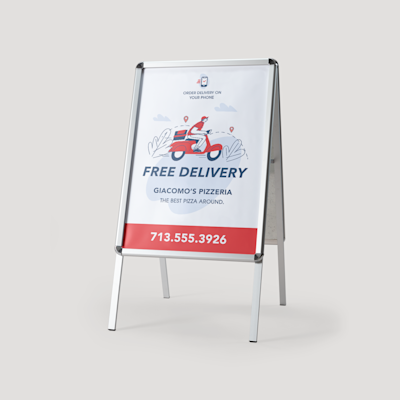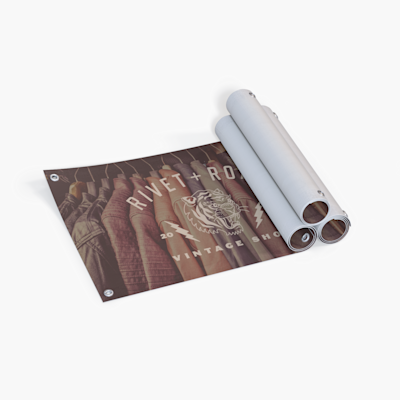Your brand colors wield a lot of power. Before prospective customers read your brand name or messaging, their brains process the colors within your logo, signage and marketing materials and form a visceral response. The shades and hues you select can soothe, excite, captivate or deter audiences, immediately influencing their feelings about your brand.
And the first place many prospective customers will see your brand is your signage…whether that’s a vinyl banner or a window decal. For most physical businesses, small business signs are a key expression of your brand that you’ll want to get right.
You might be wondering what the best colors for business signs are, and the answer really comes down to what you’re trying to convey as a brand. As a business owner, you should carefully consider which colors you use for your visual brand assets.
To help ensure you create compelling signage that elicits the best responses from your audience, here’s some insight into why color matters and how to choose wisely.
Why color matters
Color plays an integral role in our lives, influencing our choices and shaping our ideas. According to color psychology, people are drawn to certain colors for various reasons, including our connections with our environment. For example, we may associate blue with clear skies and green with trees and plants.
Decades of marketing studies show color significantly impacts how consumers perceive brands and the items they sell. Research shared by color consulting company Colorcom shows that color accounts for as much as 90% of our judgment about a product and can increase brand recognition by up to 80%.
“The meanings we attach to colors are affected by the specific experiences we have with them, so select accordingly” says Environmental and Design Psychologist Dr. Sally Augustin, Ph.D.
In other words, each color can elicit both positive and negative emotions based on an individual’s culture, memories and societal expectations. So, how can you be sure you’re selecting appropriate colors for your key branding, such as your small business signage?

How to choose the best colors for your brand signage
If you’ve already designed your logo or have an established brand identity, you’ve already got a head start on selecting colors for your signage. If you’re a newer business owner and haven’t yet made those decisions, though, here are three steps to help you get started:
1. Understand color associations.
A recent study published by the Association for Psychological Science surveyed people from 30 countries and found commonalities over which emotion people tended to associate with each color. The survey found 68% of people associated red with love, 52% said yellow represented joy and 35% linked blue with feelings of relief — all some of the best colors for business signs.
People also tend to associate blue with trustworthiness, which is why it’s often used by financial institutions. Meanwhile, black is considered sophisticated, making it an excellent choice for luxury brands. People link purple with calmness and relaxation, which may be why it’s popular among spas and other wellness companies.
2. Select a main brand color.
With so many associations, it can be challenging to choose just one color. However, picking a main brand color will help you increase brand recognition.
Take time to consider the primary feeling or emotion you want people to associate with your brand. For example, if you are a dietician or nutritionist, you might choose green since people often link green to health, freshness and rebirth.
3. Choose two to three secondary colors.
Next, identify additional colors to round out your palette. These colors can be used as backgrounds or accents to help important information stand out. For example, you might choose pink as your main color but use gold to highlight essential details on your signage.
When creating a palette, it can be helpful to use one of these formulas:
- Monochromatic. Variations of a single color that are created by adjusting the saturation, or intensity level of that color.
- Analogous. Colors that are side by side on the color wheel, such as blue and violet.
- Complementary. Colors that are opposite of each other on the color wheel, such as blue and orange.
- Triadic. Colors that form a perfect triangle on the color wheel, such as purple, orange and green.
You might also consider choosing colors that have a personal or cultural connection to your business. For example, Jah Jah’s signage (seen below) uses Afro/Rasta colors that are true to the cuisine they offer.
VistaPrint Tip
If you’re not sure which colors to choose, VistaCreate’s color palette generator can help you explore the color combinations that look best together.

Considerations for creating signs with color
Now that you’ve selected your brand colors, here are a few considerations to keep in mind when deciding how to use them to make your small business signs pop:
- Purpose. The reason or goal behind your signage can impact the colors you choose. For example, if you’re ordering a vinyl banner to announce a special event, you might use your secondary colors to set it apart from the main brand color or logo on your marquee sign.
- Legibility. When placing text on a background, avoid using multiple bright or clashing colors and ensure there’s plenty of contrast. For example, place light blue text on a navy blue background instead of a white one.
- Layout. Colors can help balance your design’s layout and draw your audience’s eyes to the most pertinent information. For example, when creating a design for a tabletop sign outlining your loyalty program, you might choose a pop of color to highlight the main message in the center and select neutral tones elsewhere.
VistaPrint Tip
Need help creating eye-catching and colorful signage? Hire a trusted professional designer who can lend their creative eye and design skills to help you stand out.
Small business signs are essential for attracting foot traffic to your brick-and-mortar, cultivating trust in your products, driving interest ahead of a big event and more. The colors you choose for your signs can significantly impact how well you achieve those objectives. By following best practices, you can ensure your signage and other visual brand assets make customers feel good about your business.



